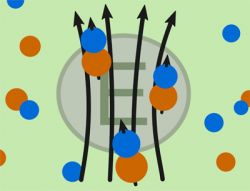
In cooperation with theoretical physicists from France and Great Britain, experimental physicists in Innsbruck have succeeded in producing ultracold dense and stable trapped samples of rubidium-cesium molecules. The particular properties of these ultracold molecules render them suitable for investigating new quantum states of matter and applying them to quantum simulation.
Many research laboratories have been using the technique of laser cooling to produce ultracold atom clouds. In the last few years, it has been refined to perfection in order to use it for different chemical elements. The physicists at the University of Innsbruck and the Institute for Quantum Optics and Quantum Information (IQOQI) have contributed significantly to this development. For example, the scientists in Innsbruck were the first to produce Bose-Einstein condensates (BEC) of the elements cesium, strontium and erbium. A BEC is a new type of quantum state of matter that occurs only below a critical temperature near absolute zero.
Two elements – a complication
Cooling molecules to these low temperatures has proven to be extremely challenging and few research groups have been successful in doing it. It is not feasible to use laser cooling alone to cool even simple molecules consisting of only two atoms to reach quantum degeneracy because of the inner structure of the molecules. Therefore, the scientists from the Institute for Experimental Physics at the University of Innsbruck and the IQOQI used a different method: They first generated two separate samples of ultracold atom clouds of atomic rubidium (Rb) and cesium (Cs). “After the cooling procedure, we produced the RbCs molecules via controlled collision. By using a technique called stimulated Raman adiabatic passage (STIRAP), which uses two-frequency-stable lasers, we were able to transfer these molecules to their internal ground state with high efficiency,” explains ERC awardee Hanns-Christoph Nägerl. “The biggest challenge was to bind the atoms without releasing binding energy uncontrollably.” Moreover, the molecules had to be in their absolute ground state to be stable to all possible two-body collision processes.
The dipole moment
A crucial property of RbCs molecules is their permanent electric dipole moment. It is strongest when the molecules are in their internal ground state. Ultracold molecules with dipole moments offer a platform for exploring many new areas of physics. An externally applied electric field polarizes the molecules and, hence, aligns the dipoles. For sufficiently low temperatures the dipolar energy is then the dominant energy. So far only one research group has been successful in producing an ultracold sample of dipolar molecules with similar efficiency. However, the potassium-rubidium molecules generated at the Joint Institute for Laboratory Astrophysics (JILA) in Boulder, USA, were collisionally unstable in the ground state. Comparable to a compass needle, which follows the magnetic field of the Earth, the electric dipole moment of the RbCs molecules follows the electric field. “This enables the molecules to interact via dipole-dipole forces over a distance that is a thousand times larger than their own size,” explains Nägerl. “The dipolar interaction is dependent on the orientation of the molecules - similar to a magnet – and can be attractive or repulsive.”
New quantum states of matter
For rubidium-cesium molecules confined in optical lattices, theoretical physicists have already predicted new quantum states of matter that derive from the strong dipole moment of the molecules. Similar to the classic states of matter - solid, liquid and gas -, quantum states of matter can be distinguished by the way the molecules are arranged. The research group in Innsbruck is currently planning on experimentally realizing, investigating and proving the existence of new quantum states of matter occurring in RbCs molecular samples. “One goal would be to prove the existence of the so-called supersolid phase”, says Nägerl. This phase, which is a mix of a solid and a superfluid, has been proposed theoretically but not been observed in experiments yet.
The results of the experiments have been published in Physical Review Letters as Editor’s Selection. The scientists are supported by the Austrian Science Fund and the European Union among others.